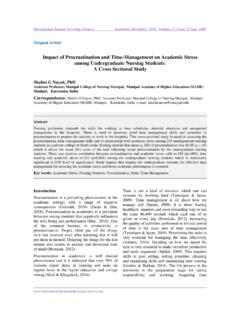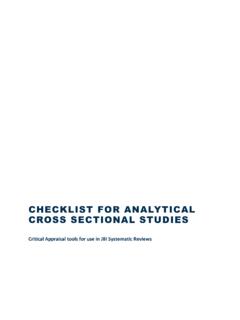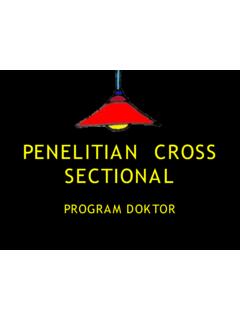Transcription of CASP Checklist: 11 questions to help you make ... - COVID19EC
1 CASP Checklist: 11 questions to help you make sense of descriptive/cross-sectional studies How to use this appraisal tool: Three broad issues need to be considered when appraising the report of a descriptive/ cross-sectional study ( , a study that collects data on individuals at one time point using a survey or review of medical charts): Are the results of the study valid? (Section A). What are the results? (Section B). Will the results help locally? (Section C). The 11 questions on the following pages are designed to help you think about these issues systematically. The first two questions are screening questions and can be answered quickly. If the answer to both is yes , it is worth proceeding with the remaining questions . You are asked to record a yes , no or can't tell to most of the questions .
2 A number of italicized prompts are given after each question. The 12 questions on the following pages are designed to help you think about these issues systematically. The first two questions are screening questions and can be answered quickly. If the answer to both is yes , it is worth proceeding with the remaining questions . There is some degree of overlap between the questions , you are asked to record a yes , no or can't tell to most of the questions . These are designed to remind you why the question is important. Record your reasons for your answers in the spaces provided. About: These questions are adapted from Guyatt GH, Sackett DL, and Cook DJ, Users' guides to the medical literature. II. How to use an article about therapy or prevention. JAMA 1993; 270 (21): 2598-2601 and JAMA 1994; 271(1): 59-63 Milton Keynes Primary Care Trust 2002.
3 All rights reserved. Referencing: we recommend using the Harvard style citation, : Critical Appraisal Skills Programme (2018). CASP (insert name of checklist Cohort study ) Checklist. [online]. Available at: URL. Accessed: Date Accessed. CASP this work is licensed under the Creative Commons Attribution Non-Commercial-Share A like. To view a copy of this license, visit Critical Appraisal Skills Programme (CASP) part of Oxford Centre for Triple Value Healthcare Ltd Paper for appraisal and reference: Section A: Are the results of the study valid? 1. Did the study address a clearly HINT: A question can be focused'. focused issue? Yes in terms of the health measure(s) studied ( , risk factor, preventive behavior, outcome). Can't Tell . No . Comments: Se evalu la disciplina/adherencia a las medidas de prevenci n y control de enfermedades en el personal de salud de m ltiples centros de salud, hospitales y dispensarios m dicos de Tanzania.
4 Poblaci n: M dicos, asistentes m dicos, enfermeras, parteras y laboratoristas de dispensarios m dicos, centros de salud y hospitales basados en la fe y privados con fines de lucro. Medidas estudiadas: medidas de prevenci n y control de enfermedades: higiene de manos, uso de guantes, manejo de desechos y desinfecci n de equipos reutilizables. Comparaci n: se compar las caracter sticas del personal sanitario y de las instalaciones estudiadas. 2. Did the authors use an appropriate method to answer their question? HINT: Consider Yes . pdf Is a descriptive/cross-sectional study an Can't Tell appropriate way of answering the question? S. Did it address the study question? No . Comments: En este caso se quer a estudiar las caracter sticas de una poblaci n determinada en momento dado (2018) para determinar si la adherencia a las medidas de prevenci n y control de infecciones eran adecuadas.
5 2. Is it worth continuing? 3. Were the subjects recruited in an HINT: We are looking for selection bias which might compromise the acceptable way? Yes generalizability of the findings: Can't Tell . pdf S. Was the sample representative of a defined population? No . Was everybody included who should have been included? Comments: La poblaci n fue tomada de la muestra final de un estudio cl nico aleatorio previo destinado a un programa de mejora de calidad. Se incluye a 223 instituciones sanitarias, y una amplia gama de profesionales de la salud de las regiones norte, sur, este, centro de Tanzania, y sus respectivas interacciones con pacientes. 4. Were the measures accurately measured to reduce bias? HINT: Look for measurement or Yes classification bias: did they use subjective or objective pdf Can't Tell measurement S.
6 Do the measurements truly reflect what No you want them to (have they been validated). Comments: Se usan variables principalmente subjetivas, ya que son los trabajadores de campo que determinan si una medida fue correctamente realizada o no. Las mediciones se realizaron basadas en herramientas de un estudio previo de Bedoya and collegues. que a su vez se bas en las gu as de la OMS. 3. Yes Consider: if the setting for data collection was justified Can't Tell if it is clear how data were collected ( , interview, questionnaire, chart review). if the researcher has justified the 5. Were the data collected in a way methods that addressed the research issue? chosen No if the researcher has made the methods explicit ( for interview method, is there an indication of how interviews were conducted?)
7 Comments: Una parte del estudio se realiza a trav s de una encuesta a los profesionales de salud y la otra parte se realiza observando la interacci n m dico-paciente para identificar la correcta higiene de manos (definida por la OMS), el correcto uso de guantes, la limpieza de materiales reusables y el desecho de residuos, cada dominio con sus items espec ficos. Para definir la adherencia se utiliz una variable dicot mica, 1 para cuando si se realizaba correctamente el proceso y 0 cuando no. Consider: Yes If the result is precise enough to make a 6. Did the study have enough decision participants to minimize the play of if there is a power calculation. This chance? will estimate how many subjects are needed to produce a reliable Can't Tell . estimate of the measure(s) of interest.
8 No . Comments: El estudio presenta 18 710 observaciones relevantes al control y prevenci n de infecciones, con 5425 interacciones medico-pacientes. Lamentablemente no hay un c lculo de la potencia del estudio, sin embargo la muestra es manifiestamente grande. Consider: 7. How are the results presented and what is the main result? Yes . if, for example, the results are presented as a proportion of people experiencing an outcome, such as risks, or as a measurement, 4. such as mean or median differences, or as survival curves and hazards how large this size of result is and how meaningful it is Can't Tell . how you would sum up the bottom-line result of the trial in one sentence No . La evidencia del estudio sugiere que las medidas de control y prevenci n de infecci n fueron inadecuadas.
9 Se utiliza porcentaje de personas que cumplen con la normativa y Odd Ratio para asociar variables. 8. Was the data analysis sufficiently rigorous? Yes Consider: if there is an in-depth description of Can't Tell the analysis process if sufficient data are presented to No support the findings Comments: Se presenta cuadros comparativos con todos los datos necesarios para que el lector realice sus propios c lculos, con los intervalos de confianza indicados. El proceso se encuentra descrito rigurosamente con el tipo de test utilizado para cada etapa del estudio y los ajustes necesarios de variables. 9. Is there a clear statement of findings? Consider: if the findings are explicit if there is adequate discussion of the evidence both for and against the researchers' arguments pdf if the researcher have discussed the credibility of their findingsS.
10 5. if the findings are discussed in relation to the original research questions Comments: Se enlistan las falencias que pudo haber tenido el estudio tanto en la discusi n como en los m todos, argumentando que a pesar de ciertas deficiencias como el efecto Hawthworn, la inadecuada practica de prevenci n debe ser tomada al m ximo. Se evidencian ciertas falencias respecto a otras variables que deben ser estudiadas en relaci n al coronavirus (material personal de protecci n) pero que no fueron posibles por la temporalidad del estudio. Se describe claramente los resultados m s relevantes del estudio y su importancia en la pr ctica cl nica. 10. Can the results be applied to the local population? HINT: The subjects covered in the study could be sufficiently different from your population to cause concern.







